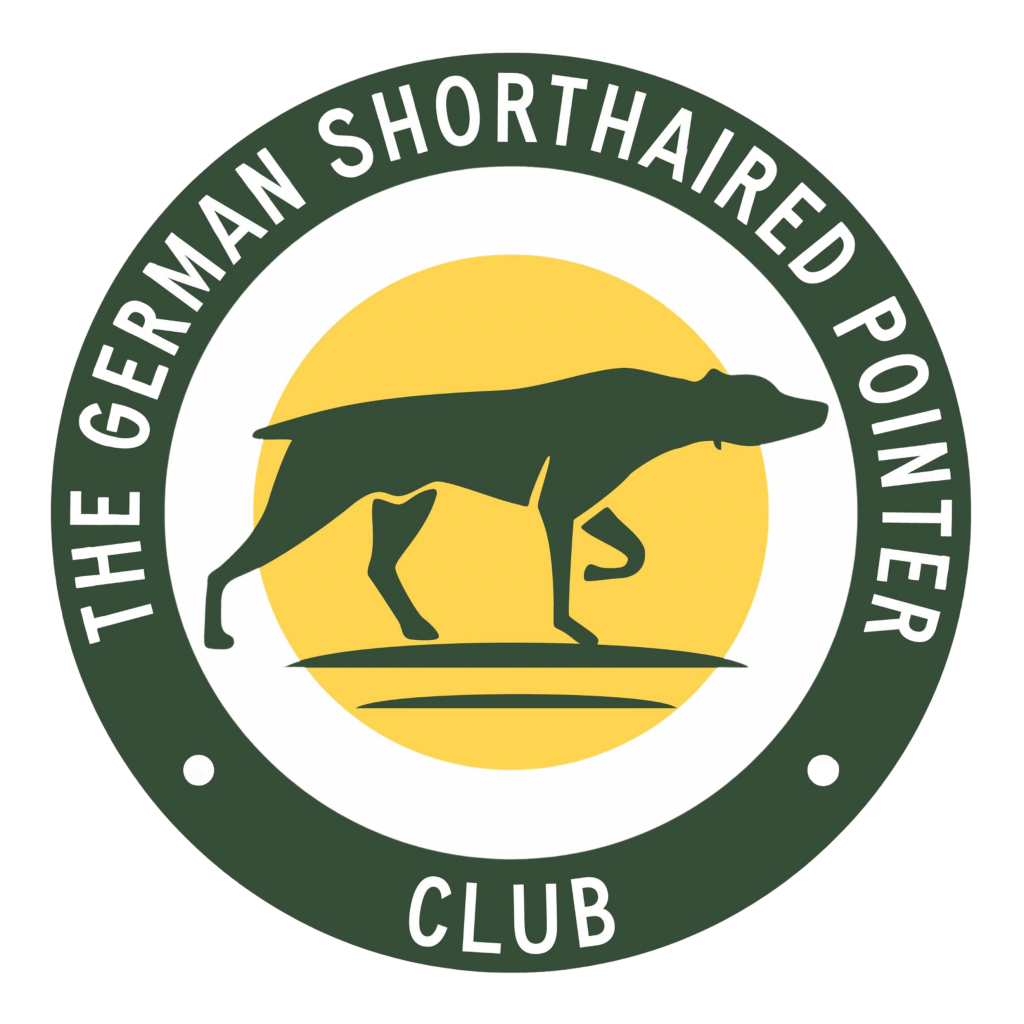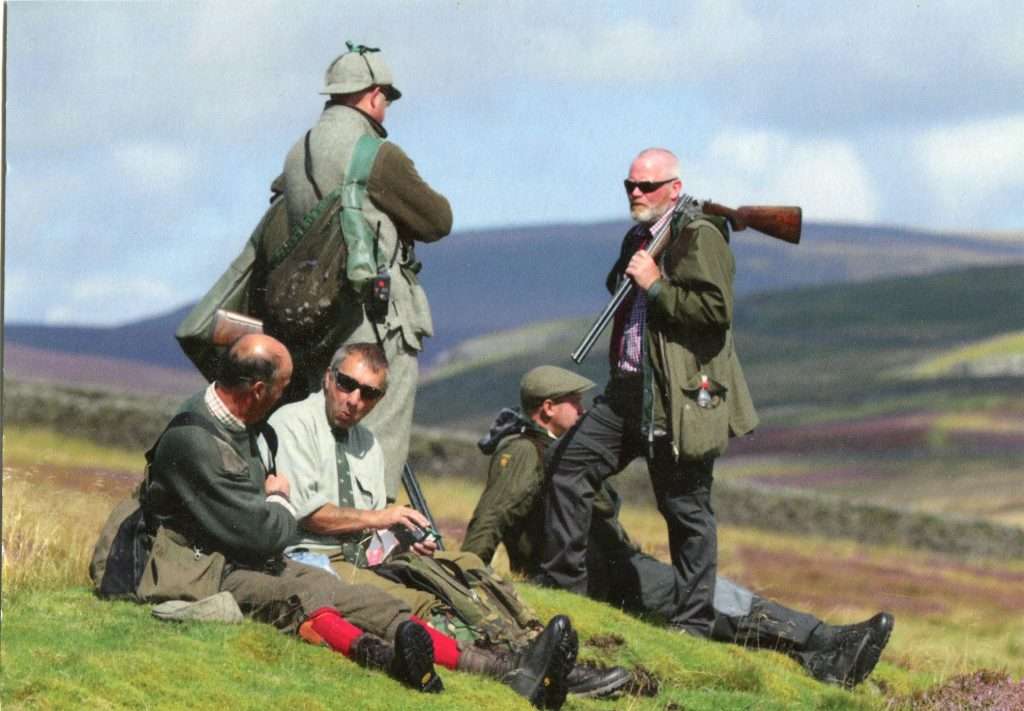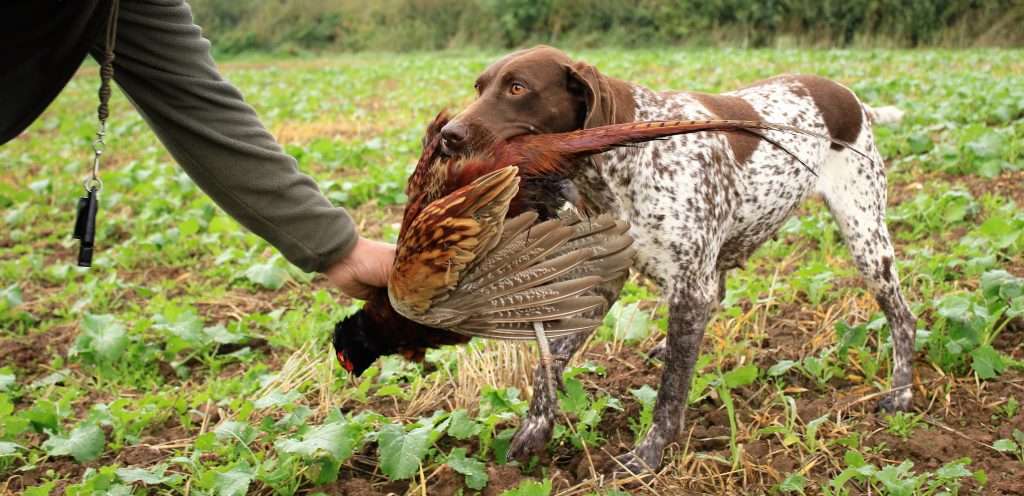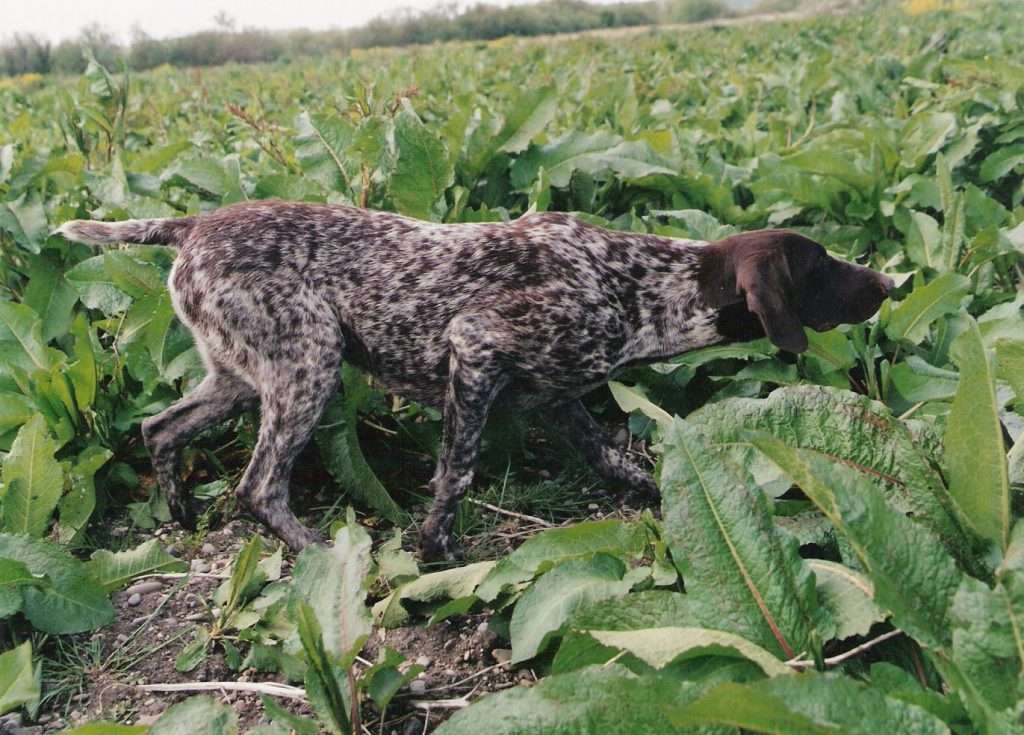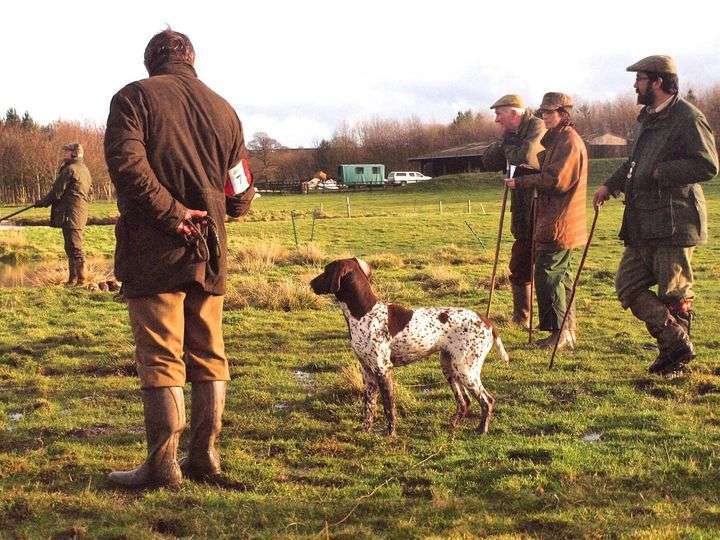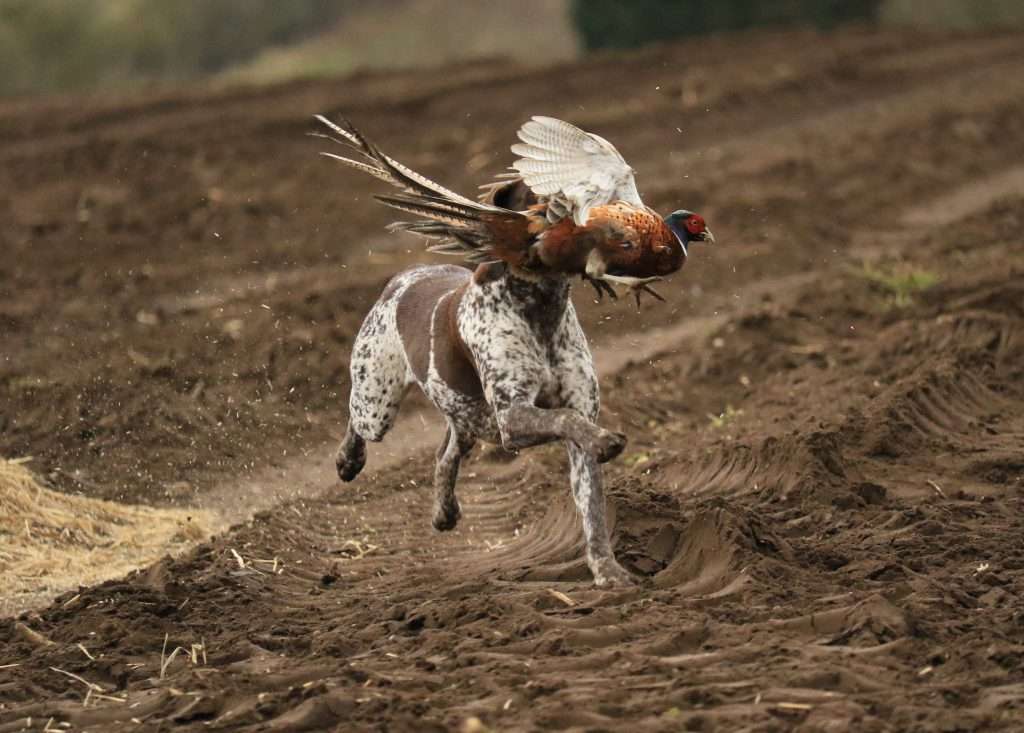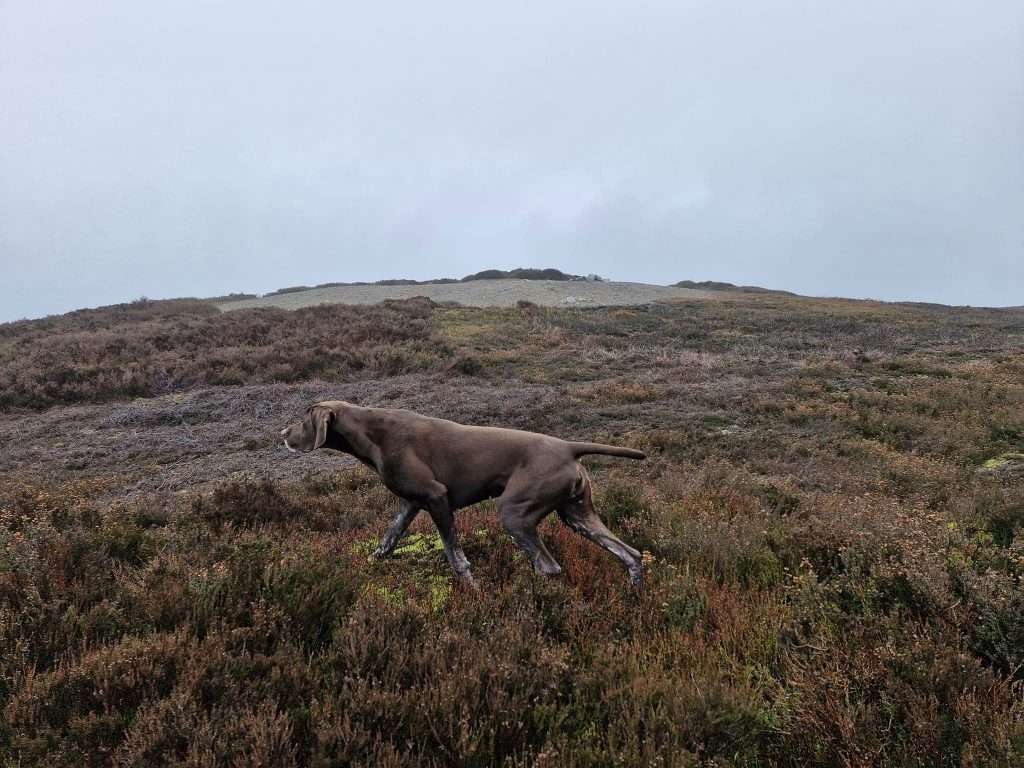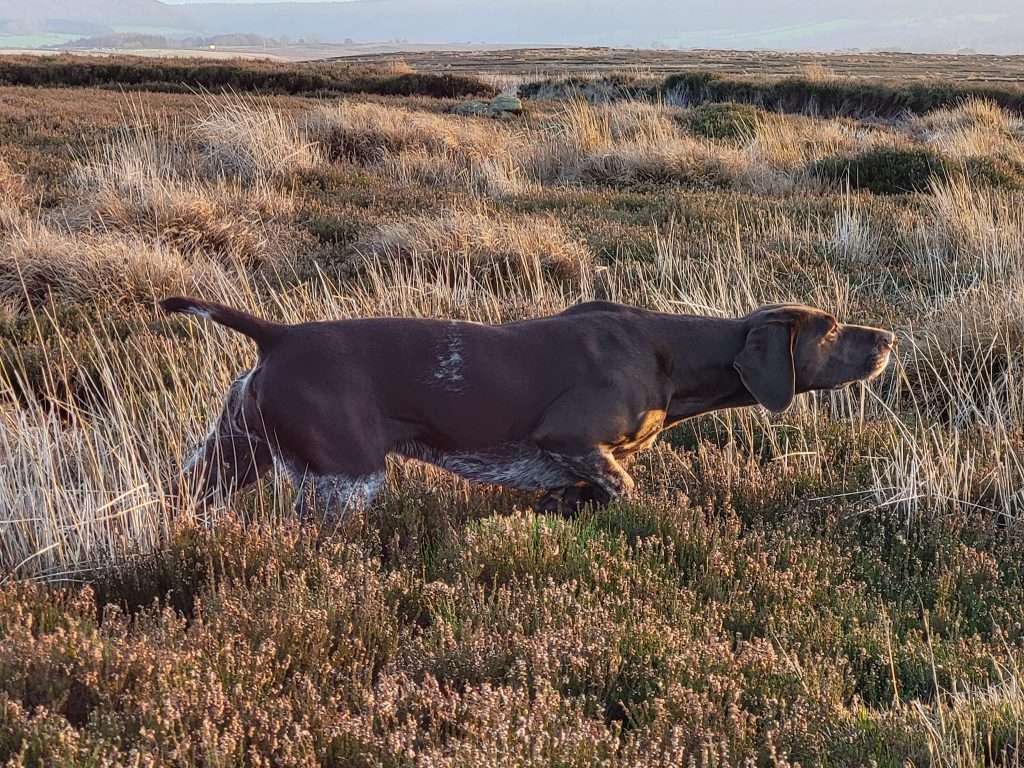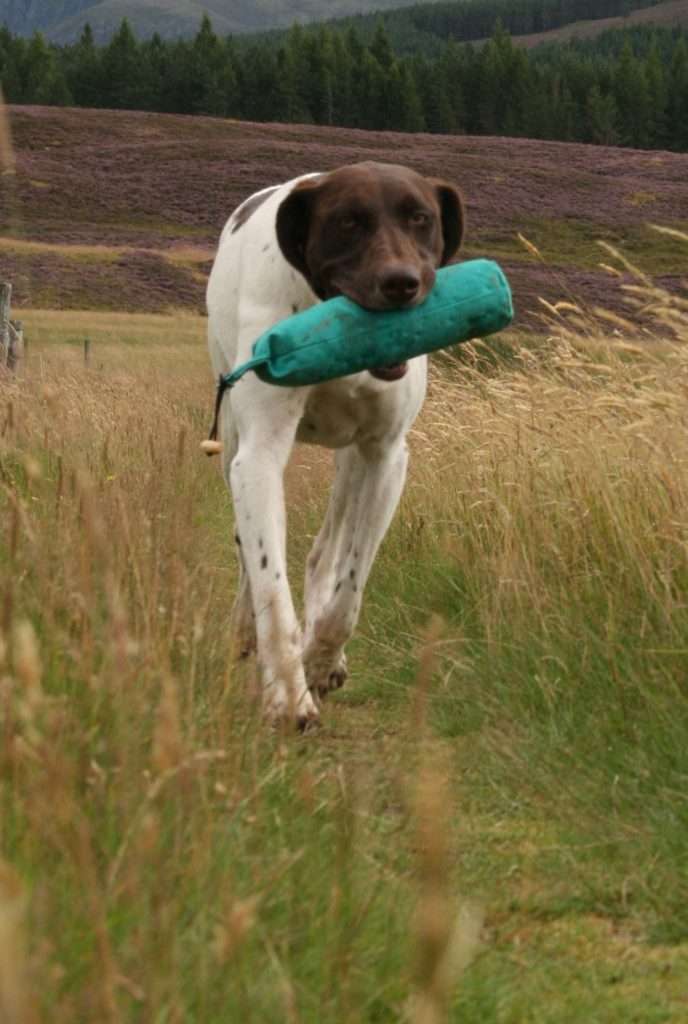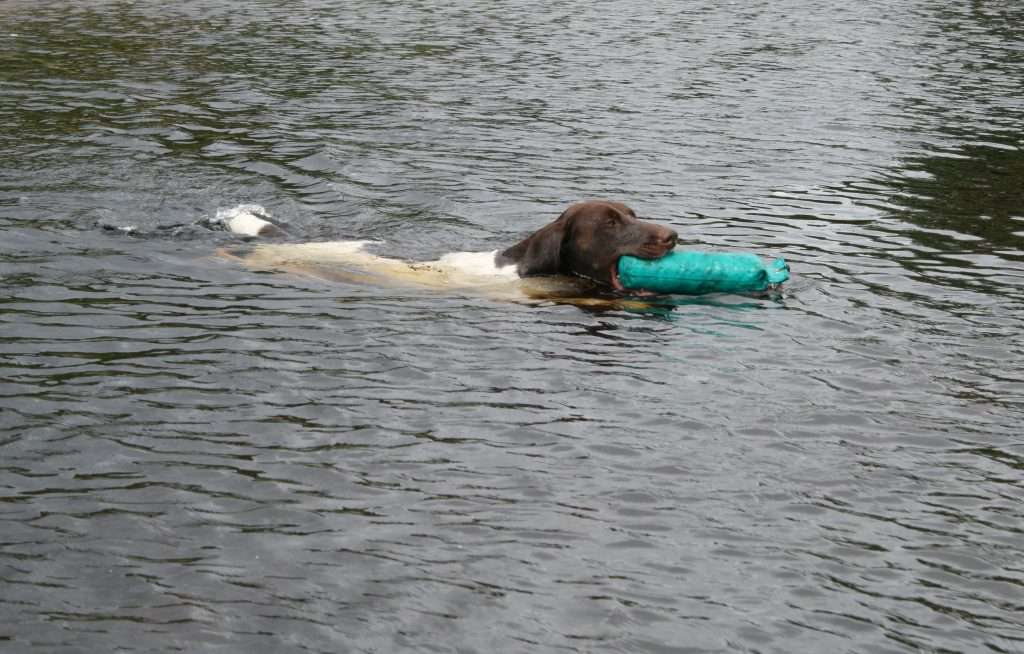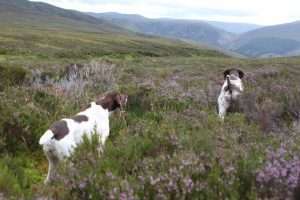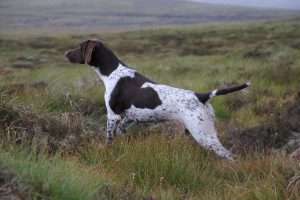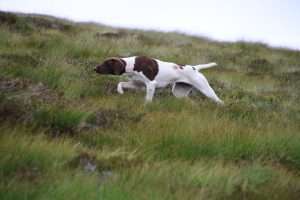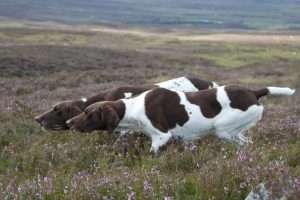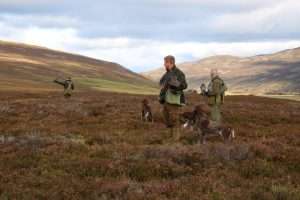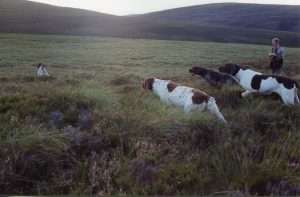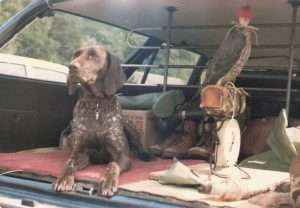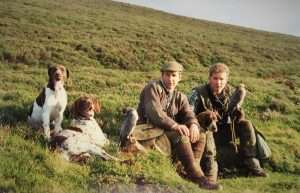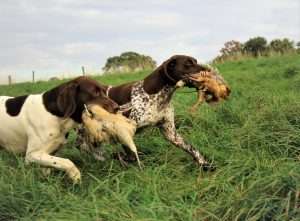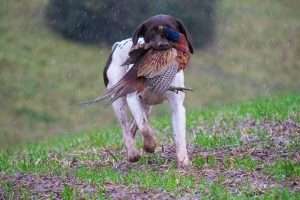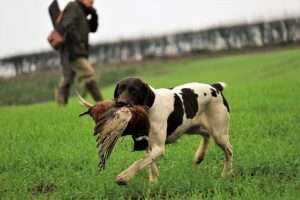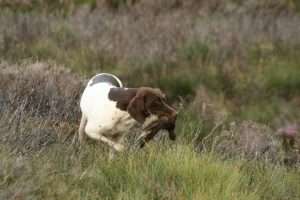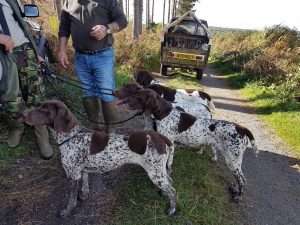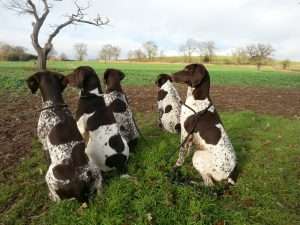Calendar of Events
Below is a calendar of all upcoming GSP Club/Branches Working Events. Please use the filters to show events from individual Clubs/Groups/Branches, event type, and month.
A comprehensive list of events for HPR’s can be found on the HPR FT INFO website. This website is independent to the Club and all Branches/Groups.
Visit HPR FT INFO websiteMay 2025
June 2025
September 2025
Field Trials
A field trial is a competition between a fixed number of dogs and their handlers, it should be based on a normal rough shooting day with a maximum of four guns.
These field trials are organised by gundog clubs around the country and operate under strict Kennel Club Guidelines, each handler will compete with one or occasionally two dogs which are run singly.
Trials are categorised into Novice, All Aged and Open stakes with competing dogs numbering from eight to sixteen depending on the stake or number of dogs entered, eight being the minimum in a novice stake, sixteen maximum in all stakes.
Awards range from first to fourth place and a certificate of merit, any of these awards will gain a dog a Kennel Club Stud Book number, two wins of first place in Open stakes would earn a dog the title of Field Trial Champion. Two judges are allocated to oversee the trial, with a steward to coordinate the smooth running of the day, a steward of the beat, usually the game keeper or estate manager, guns, and a picking up dog with handler to ensure no wounded game is left uncollected, also a person to carry a red flag who would remain with the gallery for obvious safety reasons.
Judges are usually selected by the Field Trial Secretary from a list provided by the Kennel Club to which they are approved, each dog handler will have been given an identity number before commencement of the trial and brought into the line in numerical order, the judges will give the handler a beat allocation and will have a set amount of time for the dog to complete it.
The dog will have its lead and collar removed and the handler instructed when to commence the run, the judges should be experienced and familiar in all breeds which hunt point and retrieve and use all their years of experience in working and shooting over these dogs, this is combined with all current regulations which are purposely designed by the Kennel Club to guide them and conclude whether their hunting, pointing, and retrieving are worthy of merit, dogs which do not conform are discarded, normally a dog that gets through the first run will be called up for a second or occasionally a third run.
Judges will be looking for a dog which hunts naturally, covering its beat with pace and style to excel in its game finding, be steady to shot and fall, not least to carry the game with tenderness.
At the end of the trial judges will compare notes taken during the day on dogs they think can be commended in order of attainment. Those dogs would be brought forward in a small award ceremony at the end of the day.
Trials are categorised into Novice, All Aged and Open stakes with competing dogs numbering from eight to sixteen depending on the stake or number of dogs entered, eight being the minimum in a novice stake, sixteen maximum in all stakes.
Awards range from first to fourth place and a certificate of merit, any of these awards will gain a dog a Kennel Club Stud Book number, two wins of first place in Open stakes would earn a dog the title of Field Trial Champion. Two judges are allocated to oversee the trial, with a steward to coordinate the smooth running of the day, a steward of the beat, usually the game keeper or estate manager, guns, and a picking up dog with handler to ensure no wounded game is left uncollected, also a person to carry a red flag who would remain with the gallery for obvious safety reasons.
Judges are usually selected by the Field Trial Secretary from a list provided by the Kennel Club to which they are approved, each dog handler will have been given an identity number before commencement of the trial and brought into the line in numerical order, the judges will give the handler a beat allocation and will have a set amount of time for the dog to complete it.
The dog will have its lead and collar removed and the handler instructed when to commence the run, the judges should be experienced and familiar in all breeds which hunt point and retrieve and use all their years of experience in working and shooting over these dogs, this is combined with all current regulations which are purposely designed by the Kennel Club to guide them and conclude whether their hunting, pointing, and retrieving are worthy of merit, dogs which do not conform are discarded, normally a dog that gets through the first run will be called up for a second or occasionally a third run.
Judges will be looking for a dog which hunts naturally, covering its beat with pace and style to excel in its game finding, be steady to shot and fall, not least to carry the game with tenderness.
At the end of the trial judges will compare notes taken during the day on dogs they think can be commended in order of attainment. Those dogs would be brought forward in a small award ceremony at the end of the day.
Pointing Tests
Spring Pointing Tests were first introduced to the HPR Group by the GSP CIub in 1983 and later Guidelines were formulated and agreed as to how they should be run. They are not competitions, their aim being to test and grade the natural working ability of HPRs on open ground, assessing ground treatment, hunting and pointing. As such they do not need to be licenced by the Kennel Club.
Spring Pointing Tests take place in March and April when partridges are pairing up prior to nesting. They are held on open ground, over crops such as winter cereals, rape and grass and on stubble and set-aside. The crops have to be high enough to allow cover for the birds but low enough for the dogs to hunt at speed and be seen by the judges. There is of course no shooting or retrieving, and the work of the dogs ends at flushing the birds. All dogs are run exactly the same way into the wind and are judged on the way they cover the ground in search of game and how they react when they encounter game. The Spring Pointing Test Guidelines detail clearly what the ideal pattern of work is.
The tests are judged in two categories. The Junior category is for dogs over 6 months of age and under two years on the 1st January in the year of the test. These dogs are given credit for pointing pheasants and partridges. The Adult category is for dogs over two years of age on the 1st January in the year of the test and these dogs are only credited for their points on partridges but they will be penalised if they miss pheasants. Partridges are considered the more difficult quarry to point. The dogs can achieve gradings of Excellent, Very Good or Good.
Spring Pointing Tests offer a good opportunity for handlers to assess the potential of their young dogs and for handlers who have no other facilities they provide a chance to work their dogs on game. They are friendly informal occasions where the judges can offer help and advice. Often, compared with Field Trials, Pointing Tests provide a better view for spectators of how HPRs work
Grouse Pointing Tests are also held in some parts of the Country either in the spring when the birds are pairing or in early August just prior to the start of the shooting season. Separate Guidelines for Grouse are in operation.
Working Tests
Many people, particularly those who do not come from a shooting background, begin competing with their dogs in Working Tests. These are held out of the shooting season usually between the end of February and the beginning of October. They are organised by all the HPR breed societies and in particular by our individual Branches and Groups. Schedules for working tests can be obtained from Branch and Group Secretaries and from other HPR societies throughout the summer. There are usually Puppy, Novice and Open classes and sometimes intermediate categories such as Graduate or perhaps a class for anyone who has never competed in a test before.
The tests are held on land offering a variety of types of terrain and generally consist of four exercises or tests for each category. The exercises are based artificially on the work of the hunt, point and retrieve breeds and dogs may be expected to show that they can hunt ground, be steady to shot and fall and retrieve on command over land and from water. Generally the ‘quarry’ is a canvass dummy or sometimes a cold pigeon and the gun is usually a starting pistol. Puppy tests should be very simple, testing young dogs under the age of two years in basic obedience to handlers’ commands and elementary retrieves. Novice dogs will be expected to carry out more complicated retrieving exercises, respond to commands over greater distances and perhaps jump fences. Open tests are for the most experienced dogs and all the exercises will be more difficult. At most working tests there will be a water retrieve and in the open tests this will usually consist of an unseen retrieve from across a stretch of water, only the handler knowing where to direct the dog. At the end of the day prizes and rosettes are presented usually to the first four in each category.
Many owners get their first taste of competing with their dogs at working tests perhaps having first attended Branch or Group training classes. They are very friendly occasions and there is much camaraderie between regular competitors. They enable handlers to overcome their ‘competitive nerves’ and give young dogs the socialisation they need to become good working gundogs. Working tests also give handlers the opportunity to see the strengths and weaknesses in their training programmes and they can often benefit from an exchange of ideas with others on various problems they may be experiencing with a particular dog. Some owners use working tests as a stepping stone to competing in field trials.
Grouse Counting
Most grouse keepers like to take stock of their grouse numbers whether it be counting pairs in early spring or stock numbers in July ready for the start of the grouse shooting season which commences on the twelfth of August.
Nowadays HPR breeds are becoming a popular alternative to pointers and setters, spring counting can give your young dog plenty of opportunity to point especially if being worked with other experienced dogs the grouse should be paired up if weather conditions are not exceptionally poor and should hold a territory in which they hope to nest and rear a brood, the cock bird will defend this area of the moor and be unwilling to leave when approached they often strut around in the open taunting both dogs and humans but just keeping a safe distance.
Several pointing dogs are normally used with two or three handlers, counting is far from an exact science but if it’s carried out as in previous years i.e. the same beat same wind direction similar weather conditions a comparison with historic figures can give an inkling what to expect in the coming season.
Hopefully the grouse will be in a good state of health when going to nest and produce healthy broods. After the grouse have reared their young around mid July, they stay in a family groups called a covey often two or three coveys can be found feeding together.
Once again, the idea is to work the dogs on the moor as in previous years, at this time of year care must be taken with the dogs as some broods may be late hatching which means chicks are not fully formed and lack the ability to fly far also windy days should be avoided as chicks can be blown down wind away from the call of the parent birds. If the breeding season has been good with favourable weather and chicks are free from parasitic problems numbers hopefully should be on the positive side. The wind direction may not always be in a dog’s favour when working the moor care should betaken not to let them range to far out and disturb coveys without having full control of the situation. Young birds can often be pegged when the handler is not at hand, the grouse should be pointed then a command to flush can be given, a note should be taken of how many old and young birds are in the covey this will be used to calculate the ratio of old to young birds when compared with historic figures.
Obviously double counting will arise when birds have dropped back into the heather and are pointed and counted a second time, this will always happen thus if the ground work is a mirror of previous years those similarities should already be calculated. In reality, even before the dogs get onto the moor, the keeper should have a fair idea of how the breeding season has gone but having a good count is always reassuring and pleasing.
Falconry
A Falconer’s Best Friend.
A Falconer is a person, who trains and flies falcons, the Austringer is a person, who trains and flies hawks, but the term falconer is usually interpreted as flying long or short winged birds.
The fundamentals of falconry have not changed in hundreds of years, hunting dogs were used to find and flush quarry or game and trained falcons or hawks would pursue, or stoop at whatever the dogs produced for them.
These days the sport is very sophisticated, bells which were attached to the legs or tail of the hawk or falcon to locate them after a flight, have been replaced with satellite navigation trackers, thermal imaging glasses can spot game hiding in cover, and drones are now used to exorcise birds. How things have changed.
Before I explain the role of the gundog within the sport, I need to touch on the legality of hunting wild birds or mammals with raptors.
The days when we could walk down the fields with a sparrow hawk in hand and toss it at the first blackbird that pops its head out of the hedgerow has long since gone legislation has now protected almost all wild bird species, and rightly so.
Falconers must look carefully at what is legally available for their sport which means being restricted to certain game species, wildfowl, some corvids, rabbits and hare, there are also restrictions on some ground game in curtain parts of the country.
Nowadays falcons and hawks are readily available from breeders at moderate cost depending on what you’re after. For this article I am going to concentrate on grouse hawking with peregrine falcons (long wings) a tiercel being the male.
A pointing dog is a definite requirement for this sport. It would be wise to purchase your dog/ puppy before the falcon or tiercel, long wing birds can be trained in a matter of weeks, but you will need time and patience to train your dog. There are numerous breeds of gundog which point, the choice is yours, but if you are reading this article, you may have your eye on a German Shorthaired Pointer.
I can say, hand on heart the GSP has served me well for over forty years. It is extremely biddable and can adapt to aspects of hunting, if grouse hawking is to be your forte then a dog with speed and agility that can cover vast areas of rough terrain would be a valuable asset. I think most handlers would prefer to training their new puppy themselves, but you may wish to have yours professionally trained which is always an option.
Realistically if you purchase a puppy, it maybe eighteen months or more before it is ready for working with falcons, common sense should tell you whether your dog is ready or trust worthy, impatience is a recipe for disaster I would not recommend cutting corners in training as it could be costly. Whatever you decide the German shorthaired pointer club has active branches dotted around the country and can give good sound advice, so please don’t despair if things are not going well with your training and discipline.
This article is not a comprehensive training guide but a view into the role of the HPR breeds used in falconry.
“Hypothetically” let’s imagine you have just purchased a young GSP bitch and decided to have it professionally trained, to speed things up.
Everything has gone well with her training, and she is back home settling in again. You decided to purchase a lovely first year peregrine tiercel which you have manned and been exercising to the lure, the young GSP will need to be introduced slowly and not allowed to frighten or overwhelm the tiercel. I cannot overstate the importance of a careful introduction to your falcon, if it goes badly the bird may not accept the young dog and may continually bate at the sight of it. Now that the young dog respects the tiercel and its reciprocal you can move on, Your bird’s training is coming on well it is starting to gain height so now is the time to introduce live game, quail is a good starter, its a good idea to let the dog flush the quarry if possible because you don’t want to find out your dog is sticky on point just when a falcon is waiting on, hopefully that won’t be an issue, flushing grouse on command is a must, the bird will soon start to pay attention and hopefully keep its eyes on the dog which would position it directly above the point.
Let’s say its the day before you set off, most of your gear is packed, your tiercel has enjoyed a nice bath out on the weathering ground he is busy preening himself, laying by his side fast asleep your young GSP, perfect, it’s the making of a team and it should only get better.
If you’re fortunate to have access to a grouse moor, then the sky really is the limit. If not, small syndicates are sometimes a possibility. There would normally be around three or four fellow falconers to spread the cost as it can be pretty expensive, it’s a good idea to check out the moor before booking as not all moors are well stocked.
If you have done all the basic training and everything is set, and you have booked two weeks on a grouse moore in the highlands or the borders along with accommodation and good company then the hard work should be done. The Grouse season starts on the 12th of August and ends on the 10th of December, mid-August is ideal for flying young falcons as there are plenty of immature grouse around which are considerably easer to catch than adult birds.
Towards mid September there are few easy flights to be had, by this time your falcon or tiercel should be in tip top flying condition. If you’re in the highlands the chances are the moor will stretch far up the hillside which can be beneficial in giving your falcon lift providing you have updrafts, a downdraft would be a nonstarter unless the falcon finds lift on another hillside to gain height getting above any downdrafts on the hill being worked.
If the moor is reasonably flat then your falcon will have to rely on wing power, there is no set time to fly your falcon, but most falconers like to weather their birds out in the morning offering them a bath and time to preen, then head out onto the moor mid to late afternoon obviously as the season progresses earlier flying times are needed.
Nearly all falconers have their own trusted pointer or HPR, some more reliable than others I might add, when this is apparent the offender usually ends up flying their falcon last for obvious reasons, A well trained dog often gets invited to run in tandem with others soon getting a reputation of excellence.
Once out on the hill it will be decided who will fly first, which can be an advantage as the ground is undisturbed, some falconers like to cast their bird off before letting the dog hunt, if the bird is fit and game plentiful then that can be a big bonus as the falcon or tiercel gains height, grouse are more likely to sit tight making them easier for the dog to point, the disadvantage is if game cannot be found within a reasonable time the falcon may start to tier and have to be called down wasting valuable energy. A few falconers work their dog until they find game then call the dog off point and back to heal then they cast off their falcon, after gaining height the dog is sent back to the area to re locate the grouse this method can be effective late in the season when birds are very flighty. Personally, I am not a great fan of this method, the most favourable way is to work one or more pointers or HPRs across the moor, as your dog takes scent and starts to locate birds, you may see a slight change in the dogs body language which is a precursor before it comes onto point, if a cast of dogs are running, the lead dog should be backed up by its partner both locking on to the scent, when the falconer satisfies himself birds are present, then the falcon can be unhooded, the tracker switched on, the leash and jesses removed and when the bird is ready it can be cast off, as previously described the falcon will look to gain height, if conditions are good it may come overhead as a pinprick in the sky, which is amazing to watch but sometimes just too high to make a successful strike, grouse are sometimes reluctant to break cover when this happens and a few more dogs can be sent in to assist. This usually forces one or more grouse to break cover, the second a grouse does break the falcon powers itself down to earth at lighting speed, it’s the thrill of a lifetime to watch and if the strike is successful, a plume of feathers is left floating through the air, the falcon or tiercel will usually ring up to spot its prize then alight onto it, only the falconers dog is allowed anywhere near the falcon while on a kill. This is for obvious reasons; a falcon will readily accept its companion but can take umbrage to a strange face from which he may flee. The tiercel along with his kill is picked up and re hooded, if it’s the last flight of the day then the bird can be cropped up on the fist, the reason being, the next falconer in line to fly will not want his bird to hassle another for a free meal, so there is a fair bit to remember about protocols and consideration toward your fellow falconers if you are going to get on together.
I wish you every success in your ventures, may you have many years of pleasure with your new companions.
Peter Bakewell
Picking Up On Commercial Driven Shoots
Traditionally Labradors and Spaniels are the breeds favoured on most commercial and higher end driven shoots, but with a younger generation of sportsmen on the horizon the HPR breeds are slowly finding their way into a number of these prestigious shoots, although their popularity may never match that of the former, they are formidable retrievers and can soon clear up fallen and wounded game.
Driven shoots can be extremely expensive, especially on well-established sporting estates, syndicates or farmers shoots can offer this type of shooting at moderate cost as the game keeper often works part time or the syndicate members share the work load between themselves, it then becomes less formal. When the guns arrive they may well start the day with a glass of morning wine, then draw their peg or stand numbers, this will be their number for the day. After each drive the guns may be asked to move up one or two places, this is to keep the guns particular number random, there are normally eight guns on a shoot day with the number of drives around five or six. When the guns reach their correct peg there is usually a wait as the beaters start pushing game birds toward them, the principle is the same whether on a grouse moor, open fens or woodland, some of the guns may have a dog, these should sit by the peg quietly and have little active part until the end of drive, then can start to retrieve fallen birds from around that area.
Way back from the guns and usually out of sight will be a small group of enthusiasts with their retrieving dogs. Usually there is a mix of different breeds. Handlers are paid by the estate to find and retrieve all dead and wounded game which have fallen in the surrounding cover. HPR breeds compete well with the labs but sometimes find it difficult to better a cocker spaniel when it’s dealing with thick cover, nevertheless, it makes up for it on stubble or sugar beat fields when they can range out, covering vast amounts of ground or working on driven grouse shoots.
All game birds are tied together by the neck in a brace and loaded onto a game cart, a note will be made of how many birds were shot on each drive, also a shot counter will record how many shots the guns had, and a calculation will be made of the percentage of shots to kills is recorded. When everything is tallied up each gun will receive a game card containing the total tally for the day.
The game will be stored in a game larder until such time as it is collected by the game dealer.
